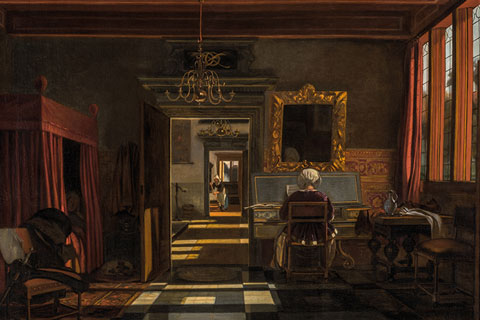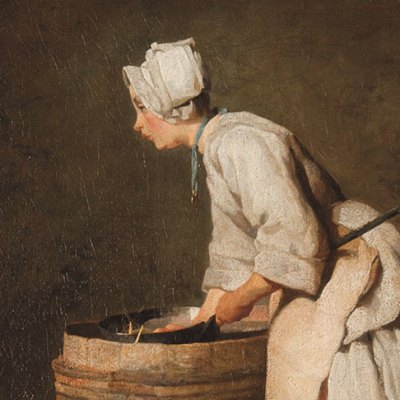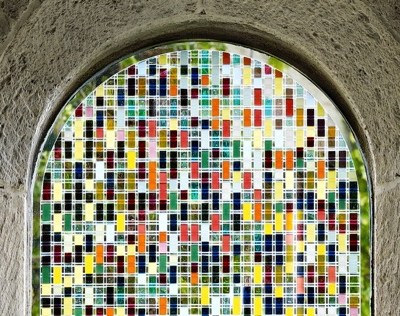This review of The Pensive Image: Art as a Form of Thinking by Hanneke Grootenboer (University of Chicago Press) was published in the July/August 2021 issue of Apollo. Preview and subscribe here.
 What does it mean to say a painting thinks? The central claim of this invigorating book is not that a painting can show thought happening, as in depictions of melancholics musing, head on hand; nor that it can illustrate philosophical concepts. Nor does Hanneke Grootenboer want to argue that a painting is a way of working out a philosophical conundrum; nor even that it can prompt theorisation about the nature of reality, artifice and representation. She argues, instead, for something weirder – and more suggestive. Discussing the sense of momentariness and interruption created by the awkward hang of a jacket and its suspended fastenings in an interior scene by the Dutch artist Cornelis Bisschop, she asks: ‘Do we, as viewers, find ourselves pondering these things, or is the painting as such pensive?’
What does it mean to say a painting thinks? The central claim of this invigorating book is not that a painting can show thought happening, as in depictions of melancholics musing, head on hand; nor that it can illustrate philosophical concepts. Nor does Hanneke Grootenboer want to argue that a painting is a way of working out a philosophical conundrum; nor even that it can prompt theorisation about the nature of reality, artifice and representation. She argues, instead, for something weirder – and more suggestive. Discussing the sense of momentariness and interruption created by the awkward hang of a jacket and its suspended fastenings in an interior scene by the Dutch artist Cornelis Bisschop, she asks: ‘Do we, as viewers, find ourselves pondering these things, or is the painting as such pensive?’
Grootenboer wants to affirm the latter, but not as a universal claim about all painterly making, or, despite her book’s subtitle, all art. Instead, she advocates for the particular qualities of what she calls ‘pensive images’. ‘Pensive’ names a distinctive mode of thought: not theorising, not logical reasoning, not critique, but, as its origin in the Latin verb pendere suggests, weighing, pondering, considering. It shares that root with ‘suspension’, and suggests irresolution, a process still in progress: as another etymological sibling implies, that something is pending, judgement yet postponed. In the pensive image, ‘we are asked not to decipher, but to muse’. Grootenboer proposes that art history respond to this call, arguing that pensive images offer ‘the glimmerings of a new methodology that would slowly pull us away from interpretation and toward a state of suspension where thinking can take place’.
Interior with Jacket on a Chair (c. 1660), Cornelis Bisschop. Gemäldegalerie der Staatliche Museen zu Berlin. Photo: bpk/Gemäldegalerie, SMB/Jörg P. Anders
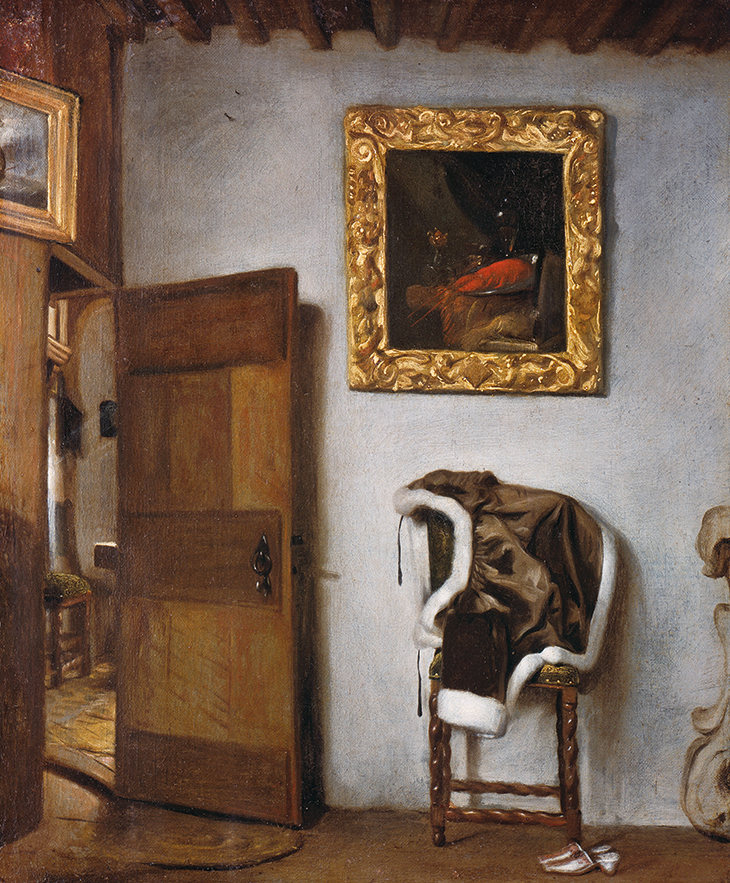
The images that matter here are not famous artistic conundrums, such as Las Meninas or The Arnolfini Portrait, which have prompted reams of comment. Instead, Grootenboer invites us to contemplate images whose provocation to philosophers is not so overt, and which indeed might seem to resist verbal elaboration or argument – whose pensiveness, indeed, ‘causes [them] to remain inexpressive’. Her touchstones are 17th-century Dutch still lifes and interiors, also the subject of her earlier book The Rhetoric of Perspective (2005), a study of realism, trompe l’oeil, and anamorphic images. In Grootenboer’s rich readings, these quiet paintings, with their meticulous rendering of quotidian objects, invite contemplation of problems of ontology and metaphysics. Adriaen Coorte’s exquisite still lifes – black background, stone ledge, unostentatious handful of a single kind of fruit – take modesty of depiction to an extreme. Grootenboer sees in them prompts to think about void and existence, the nature of space, finitude and infinity. In Coorte’s study of three medlars and a butterfly, the apparent parsimony of subject ‘reveals an astonishing vastness at the heart of its diminutive composition’. The exaggerated recession of domestic spaces in Emanuel de Witte’s Interior with Woman at a Virginal, meanwhile, with its intersecting lozenges of light, shadow, and tile, calls us to ponder how painting articulates space, our own placement in space and time, and the architectural structure of thinking.
That the argument begins in the Dutch 17th century is not an accident: still life and interiors flourished in a republic that accumulated things, made domestic space the object of contemplation (exemplified here in a fascinating discussion of Petronella Oortman’s doll’s house), and hosted Descartes’s elaboration of a method of thinking grounded in solitary meditation, to which Grootenboer frequently turns. But while the foundations of the argument lie in the early modern period, some of the most remarkable discussions emerge in the pensive images of later eras. Coorte is illuminatingly coupled with Paul Klee, and De Witte with Vilhelm Hammershøi’s pallid, enigmatic canvases of empty rooms and windows glimpsed through open doors. Extraordinarily compelling is the final chapter’s exploration of the play of surface and depth, shadow and reflection, in the photorealist painting of Richard Estes, emerging from a discussion of the depiction of glass by the Dutch still life painter Willem Kalf. In Grootenboer’s bravura exposition of how the duplicated and reduplicated reflections meet, bend, and distort in the mid-ground of Estes’s Central Savings (1975), she achieves an equally dizzying account of how this pensive image can open space for reflection on reflection.
As this double meaning suggests, one of the rewards of Grootenboer’s argument comes when philosophical problems are realised as technique: transparency versus opacity in Jan van Huysum’s drops of dew, the overcoming of opposites in chiaroscuro. But the pensive image moves beyond the predictable line that paintings ‘think’ because they are all, somehow, ‘about’ painting. Realism, illusionistic painting, and photorealism loom so large in her discussion because it is crucial that the pensive image is of or about something else; that it ‘provoke[s] wonder about the most ordinary of things’.
Central Savings (1975), Richard Estes. Nelson-Atkins Museum of Art, Kansas City. Courtesy Menconi + Schoelkop; © Richard Estes
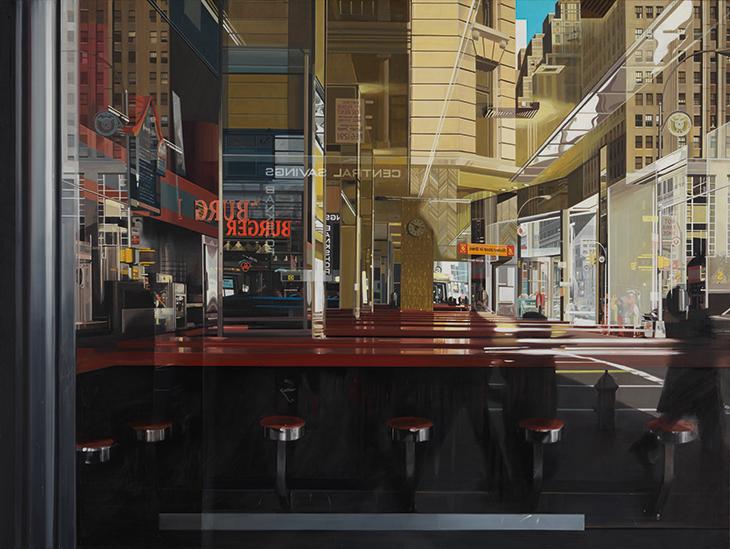
Despite the insistence that the pensive image is not a coding of philosophical concepts, Grootenboer frequently confronts these paintings of the ordinary with philosophical terms of art – Heidegger’s dwelling and Dasein, Hegel’s Aufhebung, or sublation, Husserl’s intentionality. Her discussion of Central Savings, for example, shows it corroborating Hegel’s critiques of Kant. Not all readers will find this technicality sympathetic, or indeed comprehensible. But the point of the pensive image is not to lead to particular thoughts, but to thoughtfulness. Grootenboer’s readings are exemplary, not final; an indication of how dwelling with and in a painting, and attempting to articulate it, can cause its thinking to emerge as our own.
Grootenboer claims that ‘[c]ertain paintings can be full of thoughts, but it will be unclear who exactly is thinking them’. The 18th-century physicist Georg Lichtenberg objected to Descartes’s famous proof of his own existence – ‘I think, therefore I am’ – on the grounds that all he had proved was that ‘thinking is happening’. Throughout the book, Grootenboer uses the first-person plural to describe a painting’s address: ‘we’ enter the spaces of De Witte or Hammershøi; ‘we’ contemplate the lack of our own reflection in Estes’ Central Savings; the pensive image is ‘a touchstone for our thinking about our thinking’. The pensive image elicits thought without a particular subject; in it, and through it, thinking is happening. Its bestowal of attention and bravura technique on the matter of the ordinary – this street corner, these empty rooms, this drooping tulip – leads us to ask not just why this thing and why so, but also, as Grootenboer suggests in the first sentence of this book: why is there anything at all? It, the painting, is; therefore we think.
The Pensive Image: Art as a Form of Thinking by Hanneke Grootenboer is published by the University of Chicago Press.
From the July/August 2021 of Apollo. Preview and subscribe here.
